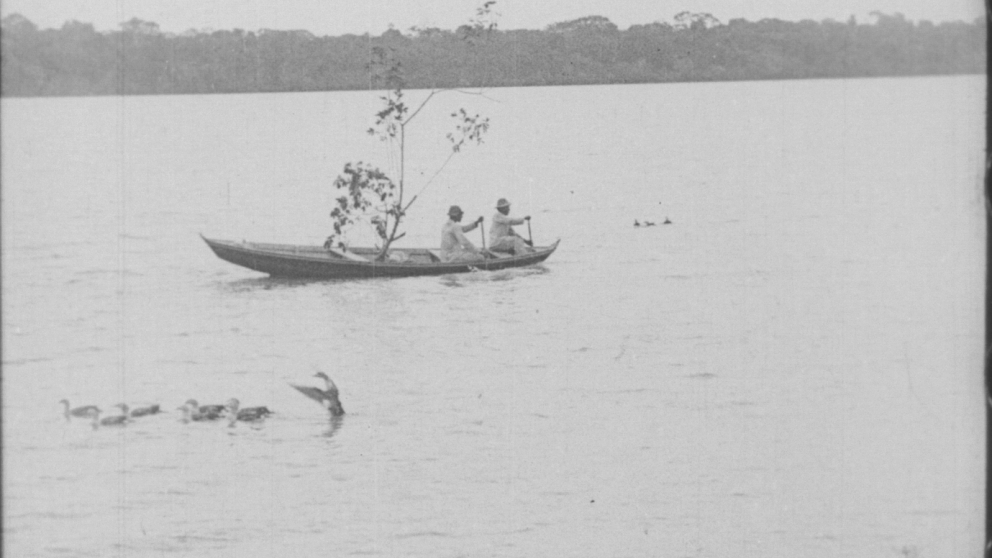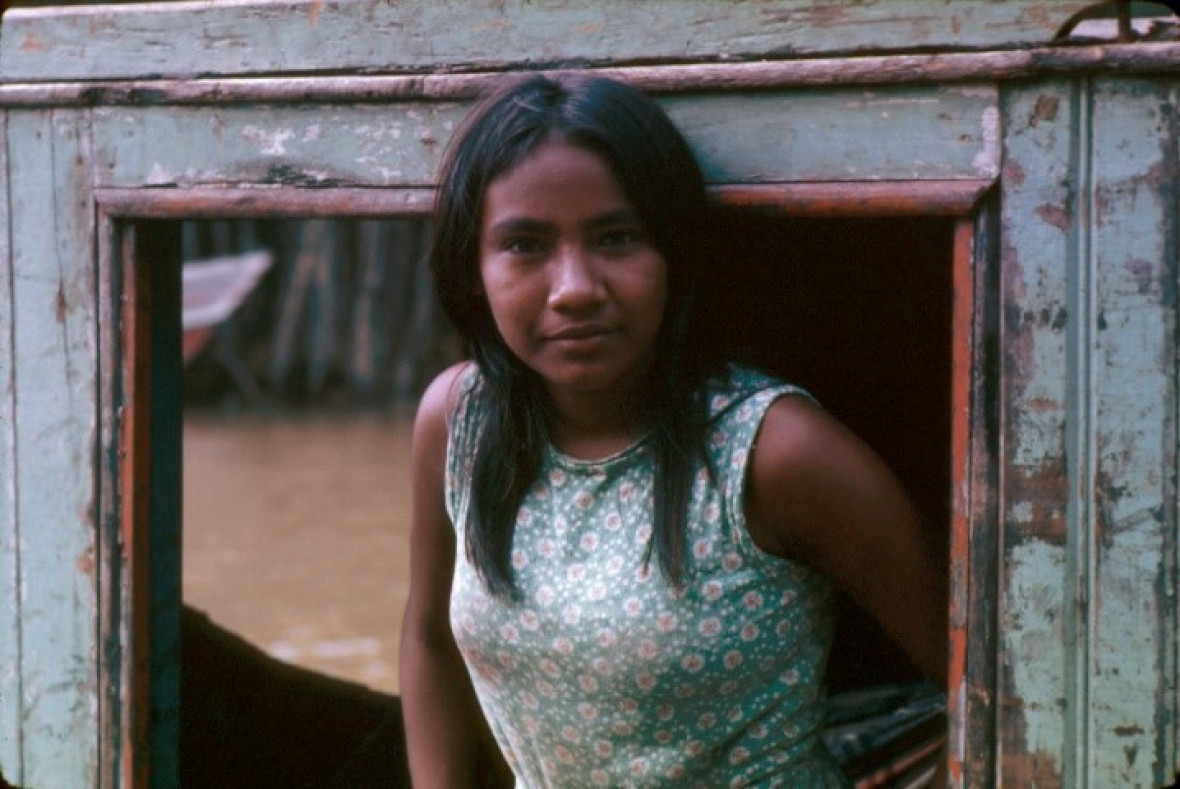Amazonia - Three Moments of Cinematography
09.10.2024

“Let everything flow, the river and the street,” announced one of the banners raised in the centre of Rio de Janeiro on the afternoon of 20 September 2024 at one of the many demonstrations for Climate Justice that brought thousands of people across Brazil to the streets that day.
The demonstrations are a response from the streets to the fires and smoke that today cover not only Brazil but several countries in the southern hemisphere and beyond. The Amazon, and other biomes such as the Pantanal and Cerrado, are being ravaged by fires and extreme drought. In the first weeks of September, the fires got out of control and produced a cloud of smoke that blanketed the entire country. In August, 28,697 fires were recorded in the Amazon alone. This figure represents an increase of 83% compared to the same period in 2023, when 15,710 outbreaks were recorded - and is 38% above the average for the previous 10 years (2014 to 2023), according to data from the National Institute for Space Research's (INPE) Burn Program. The consequence of 14 months of temperatures above 1.5ºC is an exponential increase in extreme weather events, resulting in heatwaves, droughts, intense rainfall and forest fires, both in Brazil and the rest of the world. “A ball of fire,” said shaman and Yanomami leader Davi Kopenawa, referring to planet Earth, during his participation in Amazon Week 2024, an event organized by the Brazilian Embassy in Berlin, with the support and participation of RIFS.
As the Amazon once again burns in the midst of fire and smoke, these flames have taken over cinema screens in Berlin as part of an attempt to combine the documentary experience with efforts to capture the political history of the Amazon’s climatic present. We came together to incorporate cinema as a narrative tool in researching just transformations, using it as a way to explore the scientific and social dimensions of climate change.
The film programme "Amazonia - Three Moments of Cinematography" was shown at the historic Babylon cinema in Berlin through 16–20 September 2024 as part of Amazon Week 2024. We sought, in the light of three films, to bring into sharp relief the images and narratives produced in territories usurped for different colonization projects, and how their populations, nature and modes of existence have been and continue to be brutally violated.
The three films—Amazonas, o maior Rio do Mundo (Silvino Santos, 1918), Iracema – uma transa amazônica (1974), and Serras da Desordem (Andrea Tonacci, 2006)—offer different perspectives across distinct historical periods, documenting the impact of the arrival of the white man and the colonialist idea of "development" in the Amazon. Together, they highlight the ongoing nature of transformations driven by neoliberal rationality, which remains deeply connected to colonial legacies.The films use the language of cinema as a tool to expose the ecopolitical dynamics of the Amazon – stressing the rationality of political relations and economic practices that sustain an Amazonian governance that privileges and benefits key groups – the military and an economic elite of landowners, agrobusiness, politicians – while exploiting many. Although the Amazon rainforest has been a central topic in sustainability and climate discussions for decades, the films and the current climate crisis—which can no longer be ignored—reveal how these conversations are often co-opted by market forces and state interests.
In this blogpost, we reflect on these three historical moments and consider the troubled present of the Amazon region, which is home to the largest rainforest on our planet. The policies for forest protection, indigenous land demarcation, and conservation areas seem weak and timid—if not outright cowardly—when confronted with the aggressive expansion of agribusiness and new business models such as the carbon market. These are still controlled by large companies enmeshed in international financial circuits, with global corporations making investments that rarely benefit local populations. Instead, they often bring destruction, poverty, and violence to these communities.
The Colonial Gaze and Extractivism on the Greatest River in the World
“Amazonas, the Greatest River in the World”, directed by Silvino Santos around 1918, shows the Amazon from a perspective of jingoism and economic exploitation. The film, which was stolen from Silvino but circulated in Europe in mid-1921, disappeared for decades until it was rediscovered in 2023 in the Czech Republic’s National Film Archive. Following its digitalization, the film invites us to reflect on the hegemonic cultural memory of that period and the invention of the Amazon as a market subject to the predations of extractivism.
Financed by local businessmen and politicians, the film features scenes that extol the possibilities of economic activities such as latex harvesting, felling trees, and processing wood for construction. While the (Black and Indigenous) workers toil, the finely attired industrialist robber barons oversee the pillaging of natural resources, cane in hand. The film functions as a catalogue, a kind of lexicon in which what is considered “exotic” and “wild” can be domesticated and integrated into consumption, from Amazonian manatees (a species now threatened with extinction) to indigenous headdresses and feathers. The crossings through the waters of the “World’s Largest River” serve as a showcase of inputs for national and international investors, celebrating the abundance and economic potential of the region.
A visual archive, Santos’ film presents us with a historical record that exposes the role of the Brazilian and Amazonian industrial and rural elites, their entanglement in global trade circuits, and the exploitation of what are understood to be natural “resources.” With this work, Santos seems to update the gaze of many European naturalist travellers, whose reports on the nature of what was called the New World were rooted in the question: “What is it good for?”

An Amazonian transaction: love it or leave it
In Jorge Bodanzky and Orlando Senna’s camera, the construction of the Transamazon highway tears through the forest, facilitating deforestation, timber trafficking and the spread of cattle pastures. Meanwhile, along the Amazon River, solitary settlers, connected only by a radio broadcast, are slowly deteriorated and violated by the idea of progress that the propaganda of the civil-military dictatorship (1964-1980) imposed on the country. As well as denying the existence of indigenous people and other ways of life, the government included the Amazon in the National Military Security Policy and opened up the forest to national and international investment. The main character in Bodasnky’s film, Iracema, is a 15-year-old girl who, although indigenous, denies her ethnicity in the name of survival. In the film, she is prostituted by the same development project that aims to integrate the Amazon into the country’s economy. The character Tião Brasil Grande, who drives the narrative, embodies this legacy by showing in practice the naturalization of various forms of violence: the politics of the legalities and illegalities of extractivism, the enslavement of workers, the impoverishment of communities, and the prostitution of girls and women. In Iracema, the forest is the female body itself, ravaged, exploited and destroyed.
Although censored by the dictatorial regime that ruled Brazil at the time, the film premiered in 1974 on German television (ZDF). For the first time, a global audience was able to see images of the fires in the Amazon. A German government agency acquired 100 copies of Iracema for distribution in schools, fostering the emergence of a new Amazonian imaginary beyond Humboldtian exotic tropicality. Fifty years have passed since the film’s completion and it continues to challenge the present. The day after the screening in Berlin, on the other side of the Atlantic, the restored version of the film Iracema - uma transa amazônica was released in São Paulo. The headline of one of the country's most widely circulated newspapers read: “‘Iracema’ [...] is the most contemporary film in the country.”
Mountains of Disorder - Carapiru and the Violence of Modernity
Carapirú, a nomadic Indian, survived the massacre of his Guajá group in 1977 and wandered alone for 10 years, travelling some 2,000 km before he was found. Brought to Brasília by the Indigenous expert Sydney Possuelo, he made national headlines and his origins and identity were the subject of debate between anthropologists and linguists. This is the story told in the daring Serras da Desordem, a film directed by Andrea Tonacci and released in 2006. “I wanted to reveal the humanity of each person, their identity, a personal fiction of my view of a basic Brazilian reality,” Tonacci wrote at the time.
Cristina Amaral’s precise editing and Rui Weber’s soundtrack take us through Carapirú’s own re-enactment of his escape and survival. Historical television images and scenes without dialogues build a reflective film that contrasts Carapiru’s fine technology with the so-called technological civility of the white man who invades, corrupts, annihilates and separates us from our own nature.
Particularly moving are the moments that show Carapirú’s care in keeping the flame of his fire—the only thing accompanying him—alive. An anthropologist explains how suggesting the use of a lighter or match can be perceived as violent by these peoples, as it can break the connection between the ancient fire that sustains the sky and the fires that now destroy us, like the ones causing today’s forest fires, which “bring the sky down.” Yanomami shaman Davi Kopenawa offers a striking image: this is not just a figure of speech—life as fire is not a metaphor.

To the fire that won’t go out
The three films challenge our gaze and invite us to refuse what we are and invent new ways of thinking about the region of the planet we call the Amazon. The flames of the fires are far from the fire of life of Carapirú or the audacious youth of Iracema.
There is also a more subtle side, and perhaps for this very reason the strongest, which the exhibition “Amazonia - Three Moments of Cinematography” tried to show: through the films, we witness the tireless cultural and ecological resistance of the peoples of the forest. In each of the three films shown - “Amazonas, the Biggest River in the World”, “Iracema - an Amazonian Transaction” and “Mountains of Disorder” - a panorama is developed that exposes how modernity and economic progress have been pursued at the cost of environmental, cultural and social destruction. By combining documentary filmmaking with the use of images and narratives as a form of research, we aim to make these visuals relevant to the present moment. The film programme not only raises critical questions about the ecopolitics of the Amazon but also challenges us to reflect on the urgent need to reconsider what the smoke blanketing much of South America displace about the lifestyles our so-called "advanced" societies have embraced—whether in the north or south of the Equator, this imaginary line like so many others that divide the planet.
What we still call nature, far from being a mere resource or idyllic concept, challenges both authoritarianism and capitalism by proposing relationships that dismantle economic and political exploitation. It affirms the fundamental incompatibility between the destructive fire of extractivism and the powerful fire of life we could dare to practice.
We would like to thank the Cinemateca Brasileira, Jorge Bodanzky and Cristina Amaral for having kindly provided the images and films shown in this programme.


